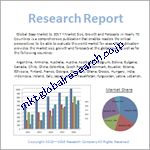目次
第1章.世界の分散型金融市場 エグゼクティブサマリー
1.1.分散型金融の世界市場規模・予測(2022年~2032年)
1.2.地域別概要
1.3.セグメント別概要
1.3.1.コンポーネント別
1.3.1.1.ブロックチェーン技術
1.3.1.2.分散型アプリケーション(dApps)
1.3.1.3.スマートコントラクト
1.3.2.アプリケーション別
1.3.2.1.資産のトークン化
1.3.2.2.コンプライアンスとアイデンティティ
1.4.主要トレンド
1.5.不況の影響
1.6.アナリストの提言と結論
第2章.世界の分散型金融市場の定義と調査前提
2.1.調査目的
2.2.市場の定義
2.3.調査の前提
2.3.1.包含と除外
2.3.2.限界
2.3.3.供給サイドの分析
2.3.3.1.入手可能性
2.3.3.2.インフラ
2.3.3.3.規制環境
2.3.3.4.市場競争
2.3.3.5.経済性(消費者の視点)
2.3.4.需要サイド分析
2.3.4.1.規制の枠組み
2.3.4.2.技術の進歩
2.3.4.3.環境への配慮
2.3.4.4.消費者の意識と受容
2.4.推定方法
2.5.調査対象年
2.6.通貨換算レート
第3章.分散型金融の世界市場ダイナミクス
3.1.市場促進要因
3.1.1.ブロックチェーン主導のDeFiソリューションの採用増加
3.1.2.スマートコントラクトとトークン化の利用増加
3.1.3.パーミッションレスで自動化された金融サービスへのアクセス拡大
3.2.市場の課題
3.2.1.規制の不確実性とセキュリティの脆弱性
3.2.2.DeFi資産の高いボラティリティ
3.3.市場機会
3.3.1.レイヤー2スケーリングとクロスチェーン相互運用性の進展
3.3.2.AIを活用したリスク評価とオンチェーン分析の統合
3.3.3.ステーブルコインと分散型取引所の利用拡大
第4章.世界の分散型金融市場の産業分析
4.1.ポーターの5フォースモデル
4.1.1.サプライヤーの交渉力
4.1.2.バイヤーの交渉力
4.1.3.新規参入者の脅威
4.1.4.代替品の脅威
4.1.5.競合他社との競争
4.1.6.ポーターの5フォースモデルへの未来的アプローチ
4.1.7.ポーター5フォースのインパクト分析
4.2.PESTEL分析
4.2.1.政治的
4.2.2.経済的
4.2.3.社会的
4.2.4.技術的
4.2.5.環境
4.2.6.法律
4.3.トップの投資機会
4.4.トップ勝ち組戦略
4.5.破壊的トレンド
4.6.業界専門家の視点
4.7.アナリストの推奨と結論
第5章.世界の分散型金融市場 コンポーネント別市場規模・予測 2022-2032
5.1.セグメントダッシュボード
5.2.世界の分散型金融市場2022年と2032年のコンポーネント別収益動向分析(億米ドル)
5.2.1.ブロックチェーン技術
5.2.2.分散型アプリケーション(dApps)
5.2.3.スマートコントラクト
第6章.分散型金融の世界市場規模・用途別予測 2022-2032
6.1.セグメントダッシュボード
6.2.分散型金融の世界市場アプリケーション別収益動向分析、2022年・2032年 (億米ドル)
6.2.1.資産のトークン化
6.2.2.コンプライアンスとアイデンティティ
第7章.分散型金融の世界市場規模・地域別予測 2022-2032
7.1.北米の分散型金融市場
7.1.1.米国の分散型金融市場
7.1.1.1.コンポーネント内訳の規模と予測、2022年~2032年
7.1.1.2.アプリケーションの市場規模・予測、2022年~2032年
7.1.2.カナダの分散型金融市場
7.2.欧州の分散型金融市場
7.2.1.イギリスの分散型金融市場
7.2.2.ドイツの分散型金融市場
7.2.3.フランス分散型金融市場
7.2.4.スペイン分散型金融市場
7.2.5.イタリアの分散型金融市場
7.2.6.その他のヨーロッパ分散型金融市場
7.3.アジア太平洋地域の分散型金融市場
7.3.1.中国分散型金融市場
7.3.2.インド分散型金融市場
7.3.3.日本の分散型金融市場
7.3.4.オーストラリア分散型金融市場
7.3.5.韓国の分散型金融市場
7.3.6.その他のアジア太平洋地域分散型金融市場
7.4.ラテンアメリカの分散型金融市場
7.4.1.ブラジル分散型金融市場
7.4.2.メキシコ分散型金融市場
7.4.3.その他のラテンアメリカの分散型金融市場
7.5.中東・アフリカの分散型金融市場
7.5.1.サウジアラビアの分散型金融市場
7.5.2.南アフリカの分散型金融市場
7.5.3.その他の中東・アフリカ分散型金融市場
第8章.競合他社のインテリジェンス
8.1.主要企業のSWOT分析
8.1.1.エイベ
8.1.2.ユニスワップ・ラボ
8.1.3.メーカーダオ
8.2.トップ市場戦略
8.3.企業プロフィール
8.3.1.エイベ
8.3.1.1.主要情報
8.3.1.2.概要
8.3.1.3.財務(データの入手可能性による)
8.3.1.4.製品概要
8.3.1.5.市場戦略
8.3.2.ユニスワップ研究所
8.3.3.メーカーダオ
8.3.4.カーブファイナンス
8.3.5.コンパウンドラボ
8.3.6.シンセティクス
8.3.7.バランサー
8.3.8.チェーンリンク・ラボ
8.3.9.寿司スワップ
8.3.10.イーンファイナンス
8.3.11.パンケーキスワップ
8.3.12. dYdX
8.3.13.レン・プロトコル
8.3.14.ソーチェーン
8.3.15.バンコール・ネットワーク
第9章.研究プロセス
9.1.研究プロセス
9.1.1.データマイニング
9.1.2.分析
9.1.3.市場推定
9.1.4.バリデーション
9.1.5.出版
9.2.研究属性
表一覧
表1.世界の分散型金融市場、レポートスコープ
表2.世界の分散型金融市場の地域別推計・予測 2022-2032 (億米ドル)
表3.分散型金融の世界市場:2022-2032年(億米ドル)コンポーネント別推計・予測
表4.分散型金融の世界市場2022-2032年用途別推計・予測(億米ドル)
表5.分散型金融の世界市場 地域別推計・予測 2022-2032 (億米ドル)
表6.北米の分散型金融市場の推計と予測、2022年~2032年(10億米ドル)
表7.米国の分散型金融市場のセグメント別推計と予測、2022年~2032年(10億米ドル)
表8.カナダ分散型金融市場のセグメント別推計と予測 2022-2032 (億米ドル)
表9.ヨーロッパ分散型金融市場 2022-2032年予測 (億米ドル)
表10.アジア太平洋地域の分散型金融市場の見積もりと予測、2022年~2032年(10億米ドル)
表11.ラテンアメリカの分散型金融市場の見積もりと予測、2022年~2032年(10億米ドル)
表12.中東・アフリカの分散型金融市場の見積もりと予測、2022年~2032年 (10億米ドル)
…
このリストは完全なものではなく、最終報告書には100以上の表が含まれます。このリストは最終成果物で更新される可能性があります。
________________________________________
表一覧
表1.世界の分散型金融市場、レポートスコープ
表2.世界の分散型金融市場の地域別推計・予測 2022-2032 (億米ドル)
表3.分散型金融の世界市場:2022-2032年(億米ドル)コンポーネント別推計・予測
表4.分散型金融の世界市場2022-2032年用途別推計・予測(億米ドル)
表5.分散型金融の世界市場 地域別推計・予測 2022-2032 (億米ドル)
表6.北米の分散型金融市場の推計と予測、2022年~2032年(10億米ドル)
表7.米国の分散型金融市場のセグメント別推計と予測、2022年~2032年(10億米ドル)
表8.カナダ分散型金融市場のセグメント別推計と予測 2022-2032 (億米ドル)
表9.ヨーロッパ分散型金融市場 2022-2032年予測 (億米ドル)
表10.アジア太平洋地域の分散型金融市場の見積もりと予測、2022年~2032年(10億米ドル)
表11.ラテンアメリカの分散型金融市場の見積もりと予測、2022年~2032年(10億米ドル)
表12.中東・アフリカの分散型金融市場の見積もりと予測、2022年~2032年 (10億米ドル)
…
このリストは完全なものではなく、最終報告書には100以上の表が含まれます。このリストは最終成果物で更新される可能性があります。
________________________________________
図表リスト
図 1.世界の分散型金融市場、調査手法
図2.分散型金融の世界市場、市場推定手法
図3.世界の市場規模推計と予測手法
図4.分散型金融の世界市場、主要動向2023年
図5.分散型金融の世界市場、成長見通し2022年~2032年
図6.分散型金融の世界市場、ポーターの5フォースモデル
図7.分散型金融の世界市場、PESTEL分析
図8.分散型金融の世界市場、バリューチェーン分析
図9.分散型金融の世界市場、セグメント別、2022年・2032年(10億米ドル)
図10.分散型金融の世界市場、セグメント別、2022年及び2032年(10億米ドル)
図11.分散型金融の世界市場、セグメント別、2022年及び2032年(10億米ドル)
図12.分散型金融の世界市場、セグメント別、2022年及び2032年(10億米ドル)
図13.分散型金融の世界市場、セグメント別、2022年及び2032年(10億米ドル)
図14.分散型金融の世界市場、地域別スナップショット(2022年・2032年
図15.北米の分散型金融市場:2022年~2032年(10億米ドル)
図16.欧州の分散型金融市場 2022 & 2032 (億米ドル)
図17.アジア太平洋地域の分散型金融市場 2022年~2032年 (10億米ドル)
図18.ラテンアメリカの分散型金融市場 2022年~2032年 (10億米ドル)
図 19.中東・アフリカの分散型金融市場 2022年~2032年 (10億米ドル)
図 20.分散型金融の世界市場、企業市場シェア分析(2023年)
…
このリストは完全なものではなく、最終レポートには50以上の図表が含まれます。このリストは最終成果物で更新される可能性があります。
The rising adoption of smart contracts—self-executing agreements coded on blockchain networks—has enabled the development of trustless and automated financial services, enhancing operational efficiency and minimizing counterparty risks. The tokenization of real-world assets, including securities, real estate, and commodities, is unlocking new investment avenues while increasing liquidity within financial markets. Furthermore, institutional investors and fintech startups are increasingly exploring DeFi applications, as they offer faster transactions, reduced costs, and cross-border accessibility compared to traditional banking channels. However, regulatory uncertainty, security vulnerabilities, and high volatility of DeFi assets remain key challenges for mass adoption.
Despite these hurdles, rapid advancements in layer-2 scaling solutions, decentralized identity verification, and enhanced compliance frameworks are accelerating the mainstream adoption of DeFi. The integration of AI-powered risk assessment tools and on-chain analytics is improving security measures and enabling efficient fraud detection within decentralized ecosystems. Additionally, the expanding use of stablecoins and decentralized exchanges (DEXs) is mitigating liquidity concerns while enhancing cross-chain interoperability across multiple blockchain networks. As more enterprises, financial institutions, and individual investors embrace DeFi-powered innovations, the market is set to reshape global financial paradigms, unlocking a multi-trillion-dollar opportunity in the coming decade.
Regionally, North America leads the decentralized finance market, driven by a robust blockchain infrastructure, strong regulatory advancements, and rising institutional investments in DeFi protocols. The United States dominates the region, with Silicon Valley and Wall Street fueling blockchain-based fintech innovations and DeFi integrations into mainstream finance. Europe follows closely, led by progressive blockchain regulations in the UK, Germany, and Switzerland, which have established DeFi-friendly environments. Meanwhile, Asia-Pacific is projected to witness the fastest growth, with China, India, and Singapore spearheading blockchain innovations, crypto adoption, and regulatory initiatives to incorporate decentralized finance into financial services. Additionally, the Middle East and Latin America are emerging as lucrative DeFi markets, as governments and enterprises actively explore decentralized financial solutions to boost financial inclusivity and economic growth.
Major Market Players Included in This Report
• Aave
• Uniswap Labs
• MakerDAO
• Curve Finance
• Compound Labs, Inc.
• Synthetix
• Balancer
• Chainlink Labs
• SushiSwap
• Yearn Finance
• PancakeSwap
• dYdX
• Ren Protocol
• Thorchain
• Bancor Network
The Detailed Segments and Sub-Segments of the Market Are Explained Below:
By Component:
• Blockchain Technology
• Decentralized Applications (dApps)
• Smart Contracts
By Application:
• Assets Tokenization
• Compliance & Identity
By Region:
North America:
• U.S.
• Canada
Europe:
• UK
• Germany
• France
• Spain
• Italy
• Rest of Europe
Asia-Pacific:
• China
• India
• Japan
• Australia
• South Korea
• Rest of Asia-Pacific
Latin America:
• Brazil
• Mexico
• Rest of Latin America
Middle East & Africa:
• Saudi Arabia
• South Africa
• Rest of Middle East & Africa
Years Considered for the Study:
• Historical Year: 2022
• Base Year: 2023
• Forecast Period: 2024-2032
Key Takeaways:
• Market estimates & forecasts for 10 years from 2022 to 2032.
• Annualized revenue and regional-level analysis for each market segment.
• Comprehensive examination of geographical trends with country-level analysis.
• Competitive landscape insights, profiling major market players.
• Strategic business analysis with future recommendations for stakeholders.
• Analysis of market structure, considering demand and supply dynamics.
❖ 免責事項 ❖
http://www.globalresearch.jp/disclaimer

